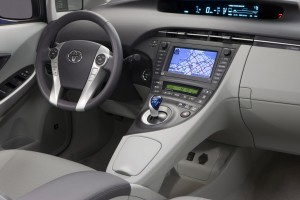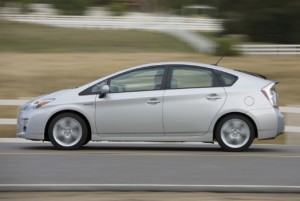
Toyota's Bob Carter fielding media questions at the 2010 Prius introduction in Detroit.
What a difference a few months can make. Just last June, Toyota couldn’t begin to keep up with demand for its Prius hybrid, with dealers literally handing over the keys as each new truckload arrived at showrooms. Lately, however, with sales of the gas/electric vehicle off by two-thirds, Toyota and its retailers are loading up on incentives to keep the market moving. Will the arrival of the all-new, third-generation Prius help? Bob Carter is certainly hoping so. The Group Vice President and General Manager of the Toyota Division of Toyota Motor Sales, U.S.A., we spoke to Carter during the first media drive of the 2010 Prius, covering everything from the weak economy and slumping fuel prices, to the debate over which high-mileage technology will eventually win – and who will bring it to market.
Q: You’ve made relatively minor visual changes to the new, 2010 Prius, but that seems to only hide the importance of the new model.
Carter: Prius is extremely significant for the brand. To many consumers, it defines the brand. We’re a full-line manufacturer with core and non-core products, and Prius has moved into the core, just like Camry, Corolla and Tundra. It’s a critical foundation for our brand.
Q: Might one even argue that it’s becoming more important than your best-selling sedan, the Camry?
Carter: Prius is something we’re extremely proud of. But I’m surprised how quickly it’s become a core of our brand. It was 1999 when we introduced Priushere and from a sales and marketing standpoint, we were very conservative, estimating only 25,000 sales a year. That’s why I am so pleased with the third-generation Prius. The first generation of buyers were early adapters who liked advanced technology. The second generation moved more into the mainstream, though Prius was still a secondary vehicle in their household fleet. The third generation is not going to be purchased just because it’s a hybrid. It’s offering packaging, performance and all the things you expect from a mainstream vehicle. It has the opportunity to be the primary vehicle for a mainstream buyer.

Prius is positioned above the new Honda Insight, at least in Carter's view of the U.S. market.
Q: We’re now seeing a flood of products entering the hybrid segment, like the new Honda Insight. Clearly, this segment is getting very competitive.
Carter: We’re sincere in the standpoint that competition brings innovation. Honda, in my view, is going for a different consumer with the new Insight. It’s an entry-level consumer and it’s a mild hybrid. It’s mid-size (for Prius) versus (Honda’s) compact. These are two of the biggest segments in the industry, and even in today’s environment, there’s plenty of room for those and plenty more. The hybrid piece of the pie is growing rapidly.
Carter: Interest in fuel economy does heighten in times of a fuel crisis. In May, June, July, consumers were standing in line for anything that got high mileage. Frankly, if anything that pulled ahead a lot of (purchases.) What we’re trying to do with the new Prius is focus on four key attributes: There’s styling; there’s packaging; there’s a technology attribute; and then the obvious, an environmental element. One of those four attributes may be more important to me than to you, but the key is appealing to the consumer on all of them, at a price that’s affordable.

Fast or slow sales, Prius is now as important a vehicle to Toyota as the Camry.
Q: There’s been a debate for years about the real cost of the Prius, most analysts assuming Toyota lost a lot of money on the original model. True? And what about the new Prius?
Carter: Barring current economic times, we’re a company that makes billions every year, and it’s difficult to produce those kinds of financial results if you’re selling cars below cost. I will tell you there’s always been marginal profit in the vehicle. It takes time to recover for R&D, but that’s really an investment for the future.
Q: But if you included all costs and didn’t use Hollywood accounting?
Carter: I can’t give you a direct answer, but now that we’re selling Priusesin the hundreds of thousands, I’m pushing for more production and the company is responding. Until recently, we were seeing such strong demand there was just a fraction of a single day’s supply. So, we have been aggressively working with the supply base and the manufacturing base to get the volumes up. You don’t do those sorts of things if there’s not marginal profits available.
Q: Last June, you sold more than 21,000 Priuses. Recently, the numbers have dropped to barely 6,000 a month.
Carter: The run rate in May, June and July was artificially inflated by (record) fuel prices. And arguably, it could’ve been even higher because I had a 0.3 days supply. Today, everything is artificially deflated. I always try to manage to a theoretical zero inventory 30 days into (the launch of) the new generation. So, we’re on that path.
Q: But you’re still forecasting annual sales of 180,000, or 15,000 monthly. Isn’t that a bit aggressive with $2 gas?
Carter: I’m being fully transparent that this is our plan. The economy and overall market conditions trumps everything. The industry is running at just 8.2 million or so, which suggests we’re bottoming out. If not, we’ll adjust our numbers accordingly. We’ll build to where the market is.
Q: You seem to be suggesting the worst is over?
Carter: I personally believe we’ve hit the floor and will begin creep off the floor starting sometime during the third quarter.
Q: There seems to be a dance underway between the economy and fuel prices, with a recovery potentially triggering another run-up at the pump. Does that worry you?
Carter: Frankly, I hope not, but I agree with you. What is in the best interest of the consumer, and the best interest of the auto industry, is not high fuel prices or low fuel prices, but stability. Now, it appears – and I’m not a Toyota spokesman on fuel prices – but it appears we’re heading for a $2.50 gallon, a point at which we’ll see stability. Long-term, however, I think it’s inevitable fuel-prices will continue to migrate up.
Q: I drove a prototype Prius plug-in, a year ago. What’s Toyota’s position on such technology, going forward?
Carter: We’re fortunate to havethe resources for an extremely aggressive R&D program. My belief is that there is not one magic bullet solution for the future. There will be several solutions, hybrids, hydrogen, pure battery vehicles, all of that. We will do a plug-in for (limited) commercial fleets, but we have to understand the durability, to make sure the new battery chemistries are ready for prime time. It’s negligible how few (NiMH) battery replacements have been needed for Prius. The second thing is the cost-benefit relationship. If you’re just commuting or going out shopping this (plug-in) could provide significant benefits. We’ll start with commercial customers then see if it’s attractive enough for consumers.
Q: So, you’re willing to let companies like GM, with its Volt, beat you to market?
Carter: Everybody likes to be first to market, but you’re better off being best.
Q: President Obama is considering whether to approve new CO2 standards, proposed by California, which would force a huge jump in mileage. Other states could pick and choose pieces of the federal or California standards. You joined Detroit’s Big Three to fight the proposed rules. What happens if Obama okays them?
Carter: What we continue to believe is that fuel economy and emissions regulations are best set at a federal level. Set them and then let’s go to work meeting them. It’s always our goal to meet and exceed them. Having a patchwork of regulations instituted by individual states would add a level of complexity that would be difficult, though not impossible, to meet. That would lead to more cost for the consumer.
